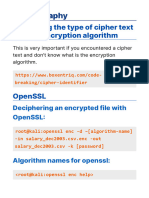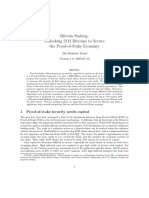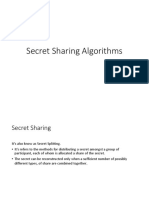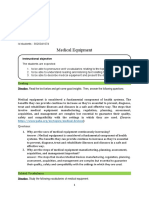0% found this document useful (0 votes)
142 views36 pagesSecret Sharing: (Or, More Accurately, "Secret Splitting")
This document discusses secret sharing, which is a method to split a secret value among multiple parties. It begins by explaining the goal of secret sharing is to allow the secret to be reconstructed only when some threshold number of parties collaborate, while preventing any subset below the threshold from learning anything about the secret. The document then covers various secret sharing schemes including the basic XOR scheme, Shamir's secret sharing using polynomial interpolation, and the more general (n,t) secret sharing where any t or more of the n shares are needed to reconstruct the secret. It also discusses applications and extensions of secret sharing like proactive secret sharing for periodically updating shares to prevent attacks if some shares are compromised.
Uploaded by
TomBikoCopyright
© © All Rights Reserved
We take content rights seriously. If you suspect this is your content, claim it here.
Available Formats
Download as PPTX, PDF, TXT or read online on Scribd
0% found this document useful (0 votes)
142 views36 pagesSecret Sharing: (Or, More Accurately, "Secret Splitting")
This document discusses secret sharing, which is a method to split a secret value among multiple parties. It begins by explaining the goal of secret sharing is to allow the secret to be reconstructed only when some threshold number of parties collaborate, while preventing any subset below the threshold from learning anything about the secret. The document then covers various secret sharing schemes including the basic XOR scheme, Shamir's secret sharing using polynomial interpolation, and the more general (n,t) secret sharing where any t or more of the n shares are needed to reconstruct the secret. It also discusses applications and extensions of secret sharing like proactive secret sharing for periodically updating shares to prevent attacks if some shares are compromised.
Uploaded by
TomBikoCopyright
© © All Rights Reserved
We take content rights seriously. If you suspect this is your content, claim it here.
Available Formats
Download as PPTX, PDF, TXT or read online on Scribd
/ 36


































































































